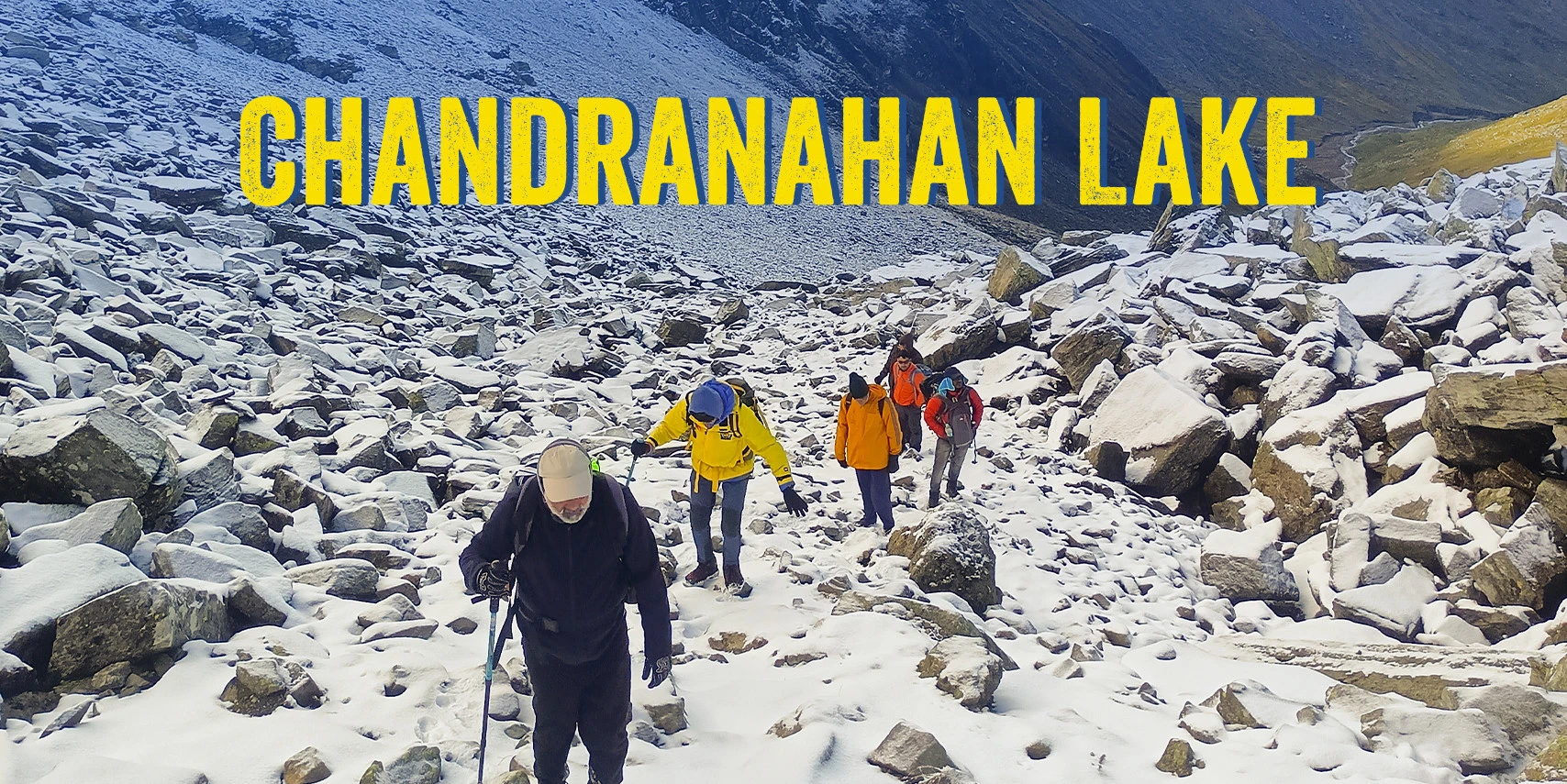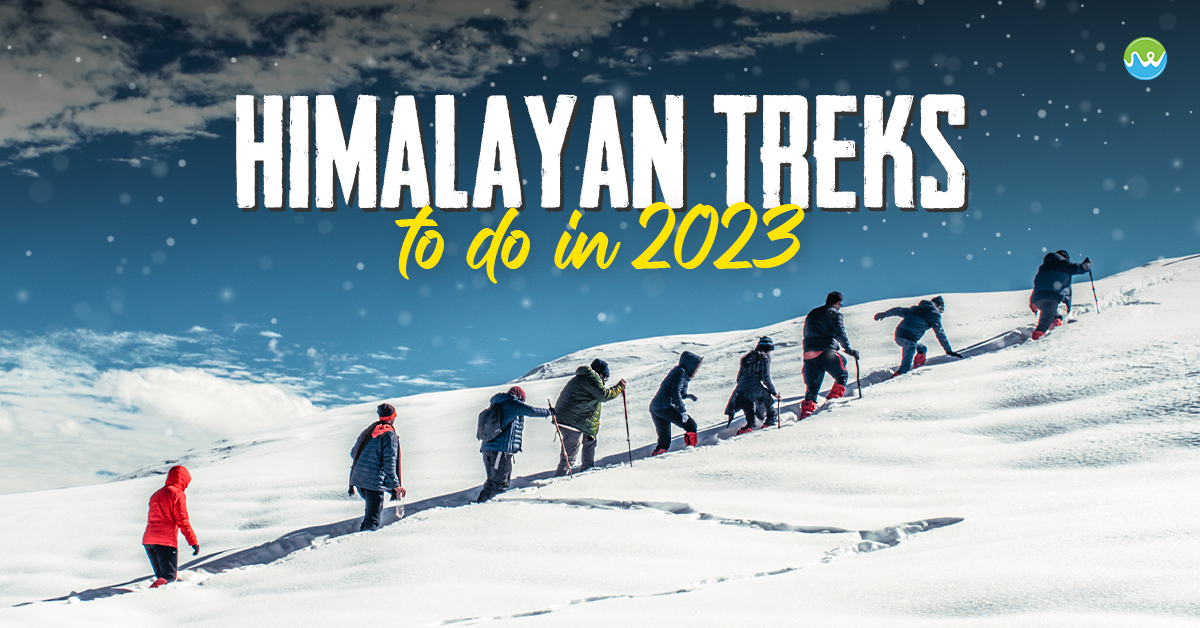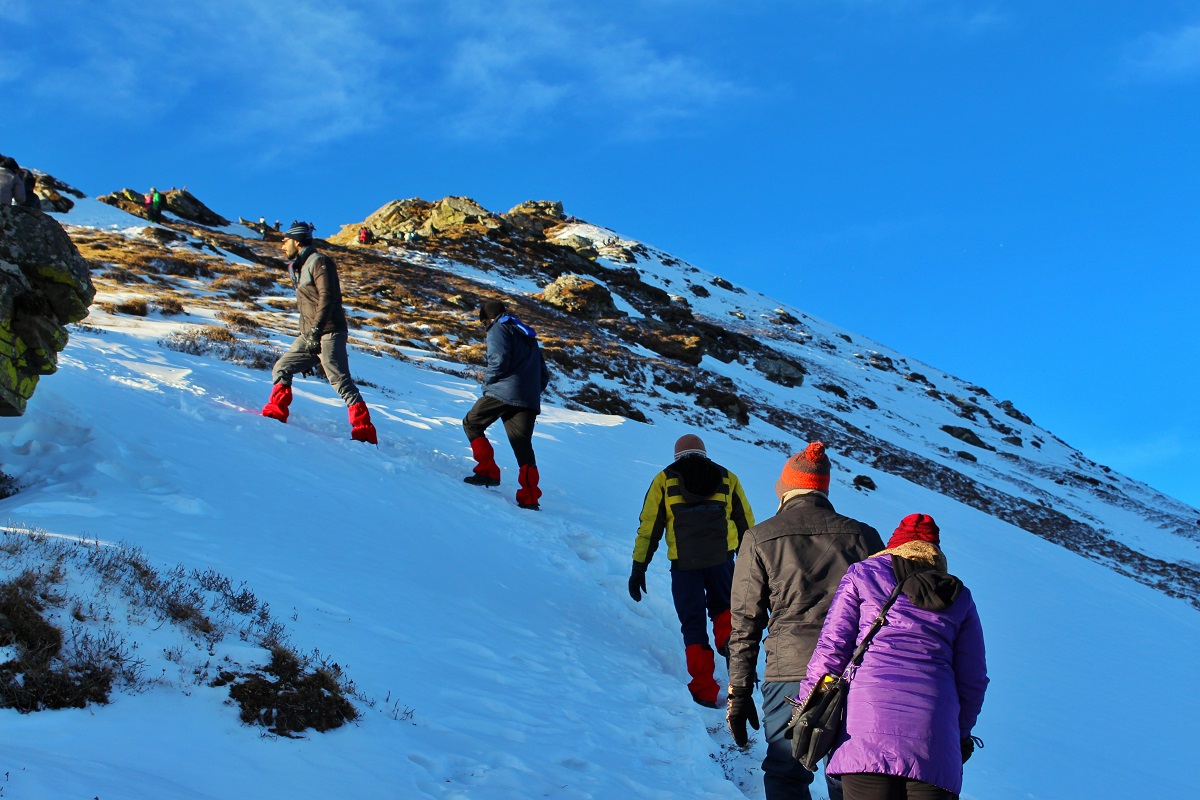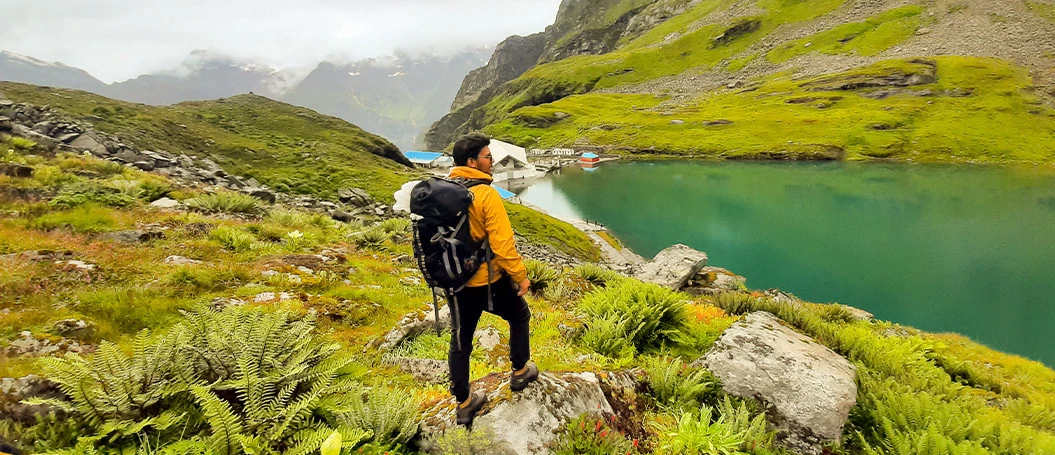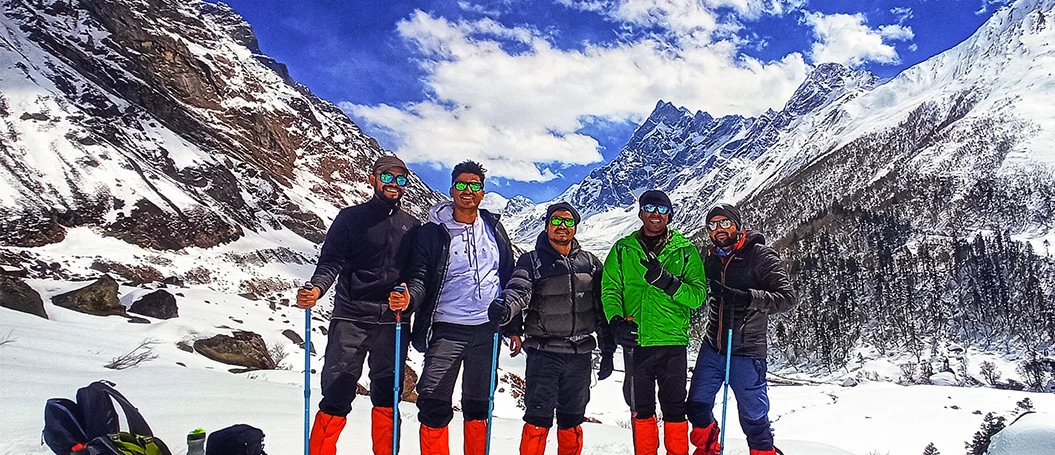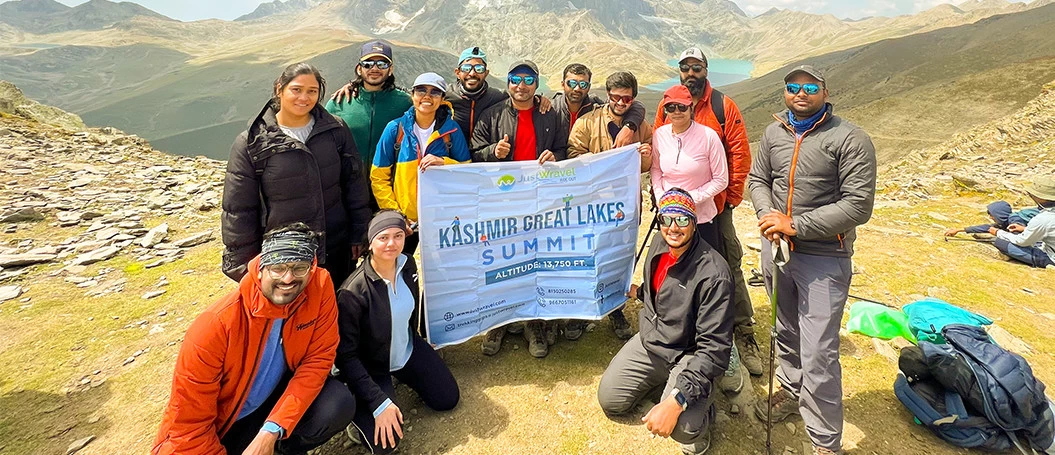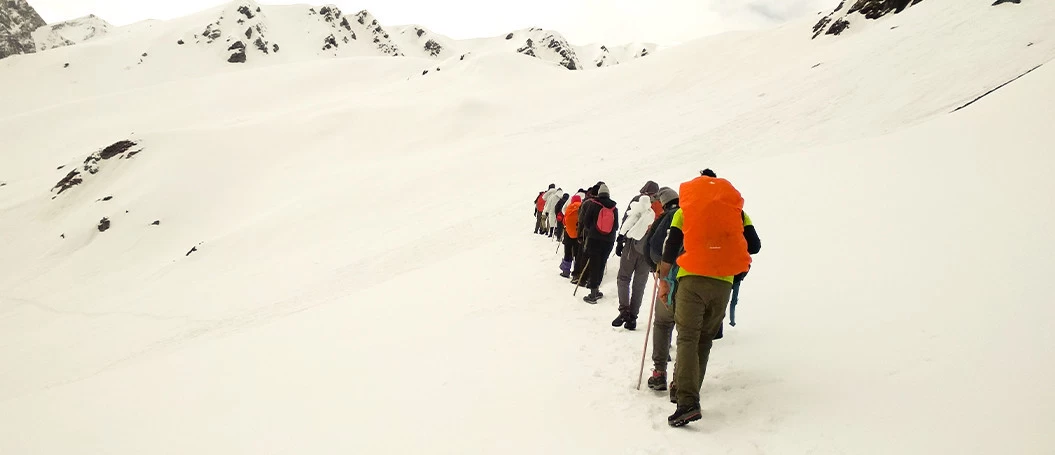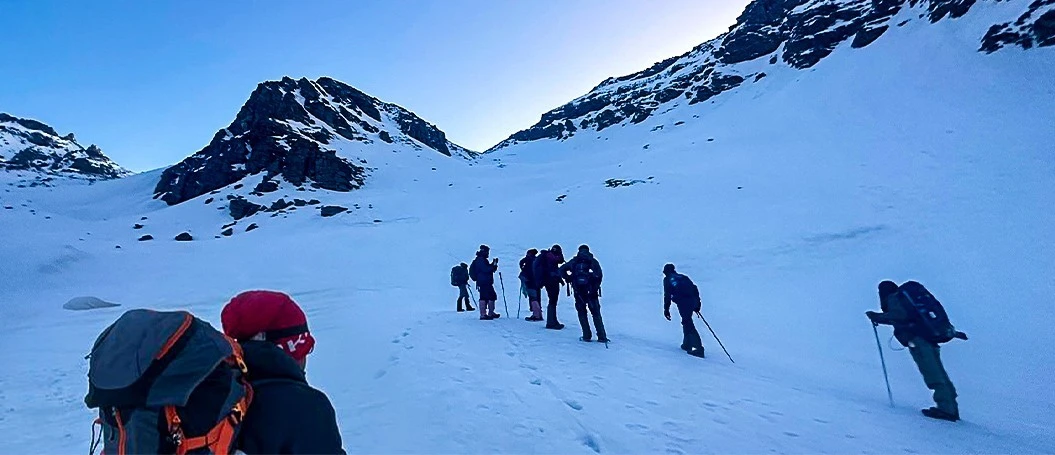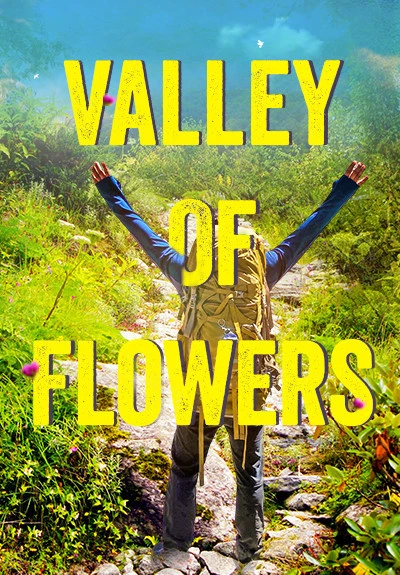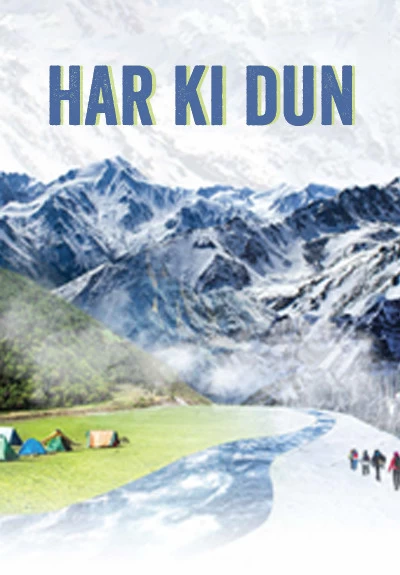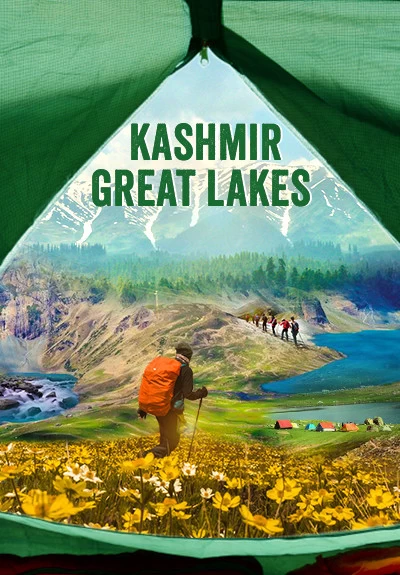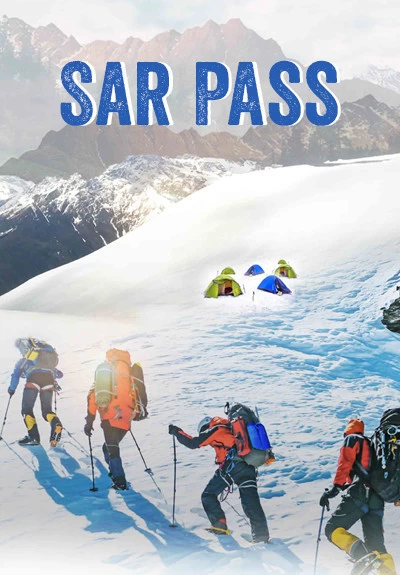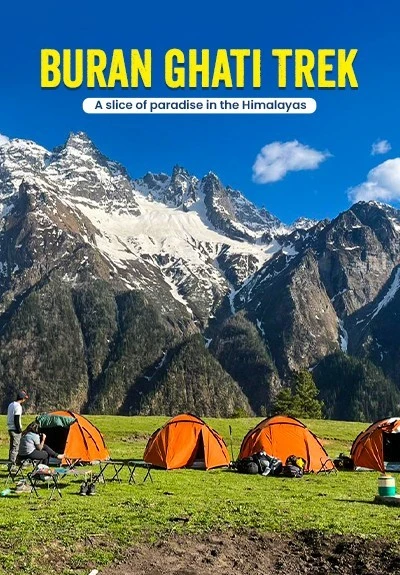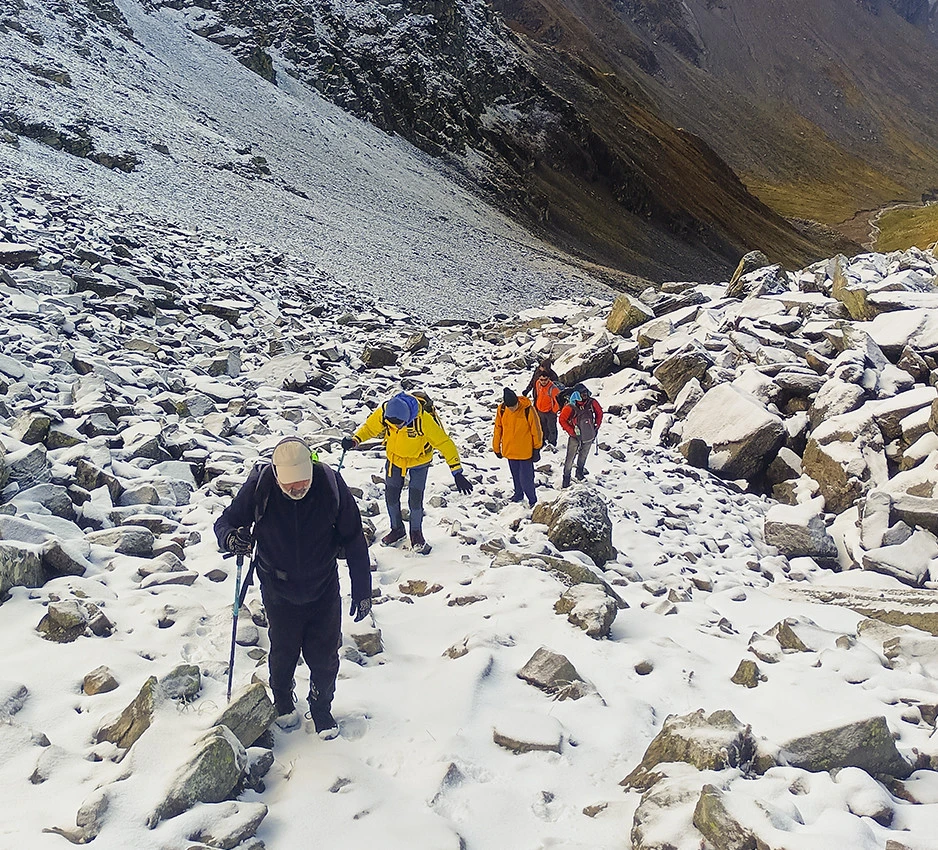
.jpg)
-0-JustWravel.jpg)
.jpg)
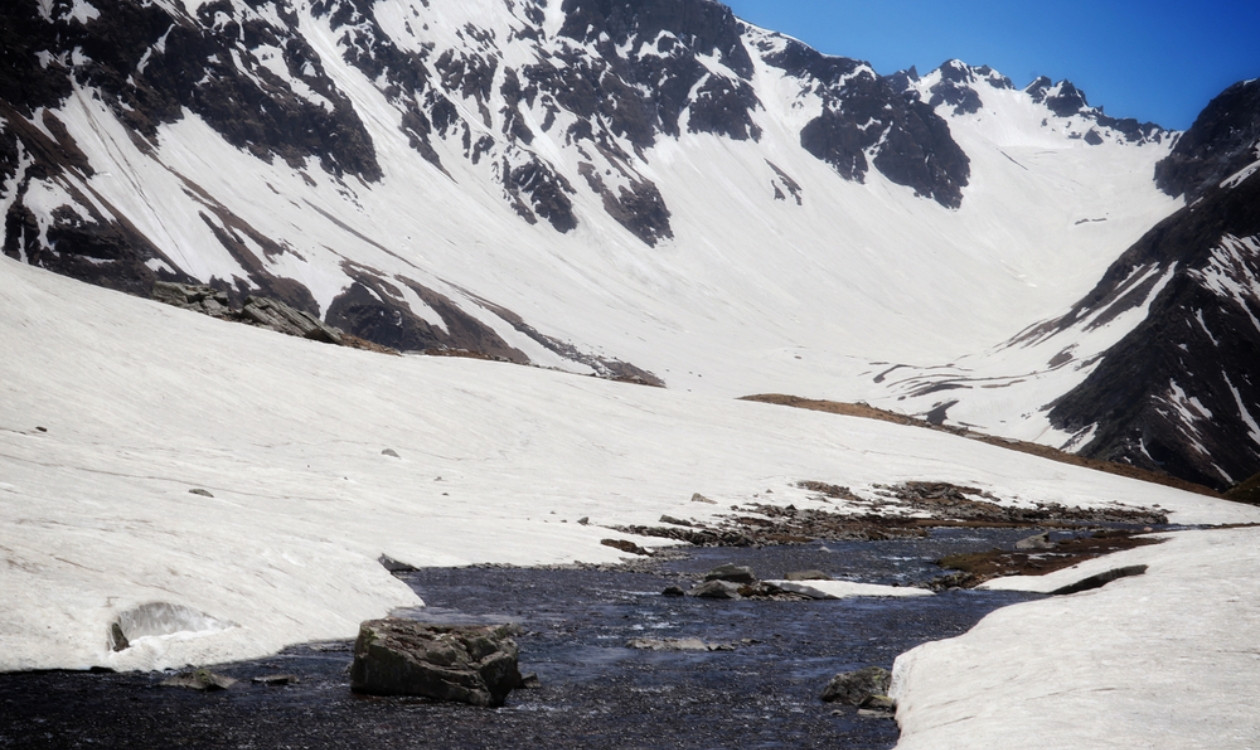
Chandranahan Lake Trek
Details
Inclusions
Safe Travel
Flexible Cancellation
Easy EMI
Certified Captains
24/7 Support
Overview
Chandranahan lake trek is known to a handful of people as its not high on the popularity charts when compared with treks like Kedarkantha, Dayara Bugyal, and more. But, don’t make the mistake of thinking that it is any less adventurous, fun, or appealing in comparison to those mentioned here. Now, Chandranahan lake is not just like any other lakes but it has historical, mythological, and geographical significance as well. It is believed that Chandranahan lake’s location is the exact place where Goddess Kali used to stay, back in the day, and is also known as her holy abode. Adding to that, it is also the birthplace of Devta Shikru Maharaj, who holds a very important place in the eyes of locals and devotees. The name of this place has an interesting story as well. And according to the legend, it says that Chandra Dev visits this place for a ritual bath every 10 years. This is why the place is called Chandra-Nahan meaning, Bath of Chandra.
Upon reaching the 9,200 ft top, which is also the Chandranahan lake altitude, one can experience true bliss and grandness of nature. The lake itself is frozen and makes up for a great view for the one who really wants to see, hidden attractions of the world. And the glitter in your eyes might not stop only there, but they’re going to brighten even more loudly. The reason being the added attraction of Chandranahan Waterfall, which is a sight to behold. The Chandranahan lake weather is something you would never be able to forget, with the serene scent of pure air and the mesmerizing surroundings. The cold weather adds to the aesthetics of the place and makes up for a trip with unforgettable memories. Moving onto the next thing which is frequently asked about the lake, the best time to visit Chandranahan Lake is during the winter months. So, when winter hits the calendar, you have at least one place you need to visit. Now, This is just enough for anyone to get onto the traveler leaving for Chandranahan Lake. Don’t you also want to get hitched for a ride to Chandranahan Lake? You do, right?
So, without further ado, pack your bags and let us take you to the Chandranahan lake trip with JustWravel.
Gallery
.jpg)
-0-JustWravel.jpg)
.jpg)

-0-JustWravel.jpg)
Itinerary
1
Day
Shimla to Janglik (150 Kms drive / 7 Hrs)
2
Day
Janglikh to Dayara Thach (8km trek)
3
Day
Dayara Thach to Litham Thach | Nearby Chandranahan Waterfall (6km trek)
4
Day
Chandranahan Waterfall to Seven Glacial Ponds | Back to Litham Thach (8 Kms trek)
5
Day
Litham Thach to Janglik Village (13 kms) | Drive to Shimla (7hrs)
Age Limit (Trip Wise)
Weekend
Getaways
18-38
Himalayan
Treks
18-48
Backpacking
Trips
18-40
Biking
Trips
18-45
Customized
Trips
No Limit
Inclusions & Exclusions
| Inclusions | Exclusions |
Accommodation: 1 Night in a Guest House / Homestay in Janglik and 3 Nights Tented Accommodation on a double / triple sharing basis as per booking. Transportation: Surface transfer from Shimla – Janglik - Shimla by Sumo / Bolero / Tempo Traveler (Depending on the number of travelers). Meals: All veg meals from Day 1st Dinner to Day 5th Day Lunch. Snacks: Morning / Evening Tea / Coffee with light snacks and soup while on the trek. Camping logistics: Trekking tent, Sleeping bags, Mattresses, Dining tent, Kitchen tent and Toilet tent. Trek Leader: Qualified and Experienced Trek leader and support staff. Permits: All necessary fees and permits. (For Indians) Trekking Equipment: Gaiters, Micro Spikes, and Rope if required. Safety Equipment: Walkie / Talkie, Basic First Aid kit with Oximeter and Oxygen Cylinder. Guide ratio: Local experience guide (depends on the group size). Others : Cloak Room facility available at base camp for extra luggage. | Any other meals during transit. Any expenses of a personal nature. Insurance of any kind. All fees and permits for Non-Indian Residence are excluded Porter/mule charges to carry your personal bag. Anything not mentioned explicitly in the above program. Unscheduled stay due to landslide and Cost Escalation due to "Force Majeure" and evacuation charges. |
Cancellation Policy
| Upto 21 days | 20-15 days | 14-8 days | 7-0 days | |
| Batch Shifting | ||||
| Cancellation Charge | Free Cancellation | 25% of the Trip Amount | 50% of the Trip Amount | 100% of the Trip Amount |
| Booking Amount | Refunded in mode of Credit Note | Adjusted in Refund Deduction | Adjusted in Refund Deduction | No Refund |
| Remaining Amount | Full Refund (minus) booking amount | Refund (minus) 25% of the trip amount | Refund (minus) 50% of the trip amount | No Refund |
Payment Policy
| Upto 21 days | 21-15 days | 14-08 days | 07-03 days | |
|---|---|---|---|---|
| Booking Amount | ||||
| 50% Payment | Optional | Compulsory | ||
| 75% Payment | Optional | Optional | Compulsory | |
| 100% Payment | Optional | Optional | Optional | Compulsory |
Things To Pack
Rucksack:
You must pick a good quality backpack with a comfortable fit and straps that won’t give you shoulder pain. You can check out your nearest Decathlon store for a good trekking backpack.
You must pick a good quality backpack with a comfortable fit and straps that won’t give you shoulder pain. You can check out your nearest Decathlon store for a good trekking backpack.
Day Bag / Day Pack:
When you head towards the summit, you are required to carry only a few necessary items and for that, you need a day backpack as you will leave your bigger one on the campsite.
When you head towards the summit, you are required to carry only a few necessary items and for that, you need a day backpack as you will leave your bigger one on the campsite.
Hiking Shoes :
Durable footwear designed for rugged terrains.
Durable footwear designed for rugged terrains.
Floaters or Sandals:
Although the entire trek requires a good quality shoe, you still need to let your feet breathe to avoid chafing and blisters. When you are at the camp, a good pair of sandals and floaters will help you to move freely.
Although the entire trek requires a good quality shoe, you still need to let your feet breathe to avoid chafing and blisters. When you are at the camp, a good pair of sandals and floaters will help you to move freely.
Tees / Tshirts:
You must keep at least three pairs of quick dry tees so that you can wash them in between stops for proper hygiene.
You must keep at least three pairs of quick dry tees so that you can wash them in between stops for proper hygiene.
Poncho:
A poncho is an evolved form of a raincoat that provides coverage to your body as well as your bag and ensures total water protection from rain.
A poncho is an evolved form of a raincoat that provides coverage to your body as well as your bag and ensures total water protection from rain.
Quick Dry Towel:
A quick dry towel will help in maintaining proper hygiene. It must dry quickly because the wet fabric will only increase the chance of bacterial growth.
A quick dry towel will help in maintaining proper hygiene. It must dry quickly because the wet fabric will only increase the chance of bacterial growth.
Sanitizer:
Essential for maintaining cleanliness while trekking.
Essential for maintaining cleanliness while trekking.
Sun Cap / Hat:
A lightweight sun cap with side flaps is perfect to keep your head cool and avoid sunburns on a sunny day.
A lightweight sun cap with side flaps is perfect to keep your head cool and avoid sunburns on a sunny day.
Sunscreen SPF 40+:
To avoid sunburns and chafing, you need to put on sunscreen as well as cold cream.
To avoid sunburns and chafing, you need to put on sunscreen as well as cold cream.
Water Bottle (Re-usable):
Hydration is extremely important when it comes to trekking. Carrying a water bottle that you can refill with Himalayan water is a must.
Hydration is extremely important when it comes to trekking. Carrying a water bottle that you can refill with Himalayan water is a must.
Personal Toiletries:
A bag with all your essentials including napkins, toothpaste, sanitizers, paper soap, etc should be carried in a ziplock bag.
A bag with all your essentials including napkins, toothpaste, sanitizers, paper soap, etc should be carried in a ziplock bag.
Personal Medication / First Aid:
A few cuts and bruises are almost inevitable when you are on a trek so carrying a medical kit with bandages, Dettol, etc is necessary.
A few cuts and bruises are almost inevitable when you are on a trek so carrying a medical kit with bandages, Dettol, etc is necessary.
Sun Glasses / Reading Glasses:
Photochromatic glasses are specs that are designed to transform into anti-glare shades depending upon exposure to the sun. They are good when it comes to eye protection but one can also opt for clip-on glasses etc.
Photochromatic glasses are specs that are designed to transform into anti-glare shades depending upon exposure to the sun. They are good when it comes to eye protection but one can also opt for clip-on glasses etc.
Charger:
To keep your electronic devices powered during the trip.
To keep your electronic devices powered during the trip.
Power Bank:
Ensures your devices stay charged when there are no outlets.
Ensures your devices stay charged when there are no outlets.
Personal Documents & ID's:
Identification proofs like Aadhar Card, Drivers License.
Identification proofs like Aadhar Card, Drivers License.
Laundry Bag (Waterproof):
In case your clothes get wet or your garments don’t dry, you can carry them in polythene. However, make sure that all the plastic that you are carrying into the woods leaves with you. Don’t litter in the mountains.
In case your clothes get wet or your garments don’t dry, you can carry them in polythene. However, make sure that all the plastic that you are carrying into the woods leaves with you. Don’t litter in the mountains.
Track Pants:
A good pair of track pants made of polyester will let your skin breathe. They’re lightweight, dry easily, and comfortable to walk around in. You can easily avoid chafing and rashes by investing in a good pair of track pants.
A good pair of track pants made of polyester will let your skin breathe. They’re lightweight, dry easily, and comfortable to walk around in. You can easily avoid chafing and rashes by investing in a good pair of track pants.
Trekking Shoes:
A good trekking shoe is comfortable, provides ankle support, and has a good grip as well. They shouldn’t be chunky, instead, they should be lightweight and sturdy.
A good trekking shoe is comfortable, provides ankle support, and has a good grip as well. They shouldn’t be chunky, instead, they should be lightweight and sturdy.
Cotton Socks:
Cotton socks are extremely comfortable to move around in and are lightweight as well which is why you can always count on a good pair of cotton socks while trekking. However, keep in mind to change them and avoid wearing them when they are wet.
Cotton socks are extremely comfortable to move around in and are lightweight as well which is why you can always count on a good pair of cotton socks while trekking. However, keep in mind to change them and avoid wearing them when they are wet.
Woolen Socks:
A good pair of woolen socks, especially merino, are comfortable, limit odors and provide adequate insulation from the cold so you can wear them at night.
A good pair of woolen socks, especially merino, are comfortable, limit odors and provide adequate insulation from the cold so you can wear them at night.
Woolen Gloves:
Insulated gloves help in maintaining proper body heat in your hands and also provide a better grasp on trekking poles.
Insulated gloves help in maintaining proper body heat in your hands and also provide a better grasp on trekking poles.
Main Jacket:
It’s emphasized that you need to carry proper layers so you can avoid getting cold which is why you need to carry a heavy jacket that you can put on over your other clothes.
It’s emphasized that you need to carry proper layers so you can avoid getting cold which is why you need to carry a heavy jacket that you can put on over your other clothes.
Woolen Cap:
A woolen cap will help prevent cold when you ascend to high altitude. You can also cover your ears to avoid any pain and discomfort you might face in them when going at high altitudes.
A woolen cap will help prevent cold when you ascend to high altitude. You can also cover your ears to avoid any pain and discomfort you might face in them when going at high altitudes.
Hoodie:
A versatile layering option for various temperatures.
A versatile layering option for various temperatures.
Scarf / Balaclava:
Along with sun rays and chilly winds, you also get hit by dirt and grime during treks which is why it's important to carry a scarf or balaclava so you can cover your face when needed.
Along with sun rays and chilly winds, you also get hit by dirt and grime during treks which is why it's important to carry a scarf or balaclava so you can cover your face when needed.
Head Lamp:
You can’t rely on moonlight when you are in the mountains. A torch or even a headlamp with a fresh pair of batteries is always a good idea to bring along.
You can’t rely on moonlight when you are in the mountains. A torch or even a headlamp with a fresh pair of batteries is always a good idea to bring along.
Trekking Pole:
The trekking pole assists in more than one way. It saves energy while also providing stability and helps you to maintain proper balance.
The trekking pole assists in more than one way. It saves energy while also providing stability and helps you to maintain proper balance.
Camera:
This should be obvious. To make sure that you get to capture all the great moments from your trek. Make sure that you have enough storage and some extra batteries as well.
This should be obvious. To make sure that you get to capture all the great moments from your trek. Make sure that you have enough storage and some extra batteries as well.
Riding Gear:
If your trip involves biking or motorcycling.
If your trip involves biking or motorcycling.
Moisturiser & Cold Cream:
To avoid sunburns and chafing, you need to put on sunscreen as well as cold cream.
To avoid sunburns and chafing, you need to put on sunscreen as well as cold cream.
Lip Balm:
Your lips can become chapped due to the harsh cold winds so it's important to keep them moisturized.
Your lips can become chapped due to the harsh cold winds so it's important to keep them moisturized.
Sanitary Pads:
Essential for feminine hygiene.
Essential for feminine hygiene.
Insect Repellent:
Guards against pesky bugs and insects.
Guards against pesky bugs and insects.
Cash:
Emergency funds for unexpected situations.
Emergency funds for unexpected situations.
Thermals:
Thermal is a piece of garment that helps in keeping your body warm in cold temperatures. It is a necessary item that you need when going on a high-altitude trek.
Thermal is a piece of garment that helps in keeping your body warm in cold temperatures. It is a necessary item that you need when going on a high-altitude trek.
Snacks / Dryfruits / Energy Bar:
Provides quick energy on the go.
Provides quick energy on the go.
Positive Attitude:
The most important item for a successful trek or trip, keeping your spirits high and adaptable to the challenges of the journey.
The most important item for a successful trek or trip, keeping your spirits high and adaptable to the challenges of the journey.
Everything you need to know about Chandranahan Lake Trek
The Chandranahan Lake Trek is a challenging and exhilarating trek in the Himachal Pradesh region of India, located in the Kinnaur district. The trek takes you through picturesque landscapes, dense forests, and steep mountain trails, leading to the mesmerizing Chandranahan Lake, a high-altitude glacial lake situated at an elevation of 4,250 meters (13,944 feet) above sea level. The lake is considered sacred by the locals and is surrounded by towering peaks, including the majestic Chandranahan Peak, which stands tall at 5,290 meters (17,356 feet). The trek to Chandranahan Lake is a 6-day journey, starting from the vibrant town of Shimla and passing through the villages of Karcham, Sangla, and Chitkul, before reaching the base camp at Kuppar Thach. The trek is classified as challenging, with steep ascents and descents, narrow trails, and high altitudes, making it suitable for experienced trekkers with a good level of fitness and prior trekking experience.. The best time to undertake the Chandranahan Lake Trek is from May to June and from September to October, when the weather is mild and the skies are clear, offering stunning views of the surrounding peaks and landscapes.
How to Reach Chandernahan Lake Trek
To reach the Chandranahan Lake Trek, you can use the following modes of transportation:
By Flight: The nearest airport is Jubbarhatti Airport in Shimla, which is approximately 25 km away from Shimla. You can take a flight from major cities like Delhi, Mumbai, Kolkata, and Bangalore to Shimla. From Shimla, you can hire a taxi or take a shared taxi to reach Karcham, which is approximately 240 km away. The journey takes around 7-8 hours.
By Train: The nearest railway station is Shimla Railway Station, which is approximately 1 km away from Shimla. You can take a train from major cities like Delhi, Mumbai, Kolkata, and Bangalore to Shimla. From Shimla, you can hire a taxi or take a shared taxi to reach Karcham, which is approximately 240 km away. The journey takes around 7-8 hours.
By Bus: You can take a bus from major cities like Delhi, Mumbai, Kolkata, and Bangalore to Shimla or Reckong Peo. From Shimla or Reckong Peo, you can hire a taxi or take a shared taxi to reach Karcham, which is approximately 240 km away. The journey takes around 7-8 hours.
Best Time to Visit Chandernahan Lake Trek
The best time to undertake the Chandranahan Lake Trek is from May to June and from September to October, when the weather is mild and the skies are clear.
Highlights of the Chandernahan Lake Trek
- Sacred Lake: Chandranahan Lake is considered sacred by the locals, and trekking to this high-altitude glacial lake is a unique and spiritual experience.
- Majestic Peaks: The trek offers stunning views of towering peaks, including the Chandranahan Peak, which stands tall at 5,290 meters (17,356 feet).
- Picturesque Landscapes: The trek takes you through picturesque landscapes, dense forests, and steep mountain trails, offering a visual treat for nature lovers and adventure seekers
- Challenging Trek: The Chandranahan Lake Trek is classified as challenging, making it a thrilling and rewarding experience for experienced trekkers with a good level of fitness and prior trekking experience
Why Trek with JustWravel
Choosing the right trek is easy, but selecting the right trekking company is the real challenge, especially when venturing into the remote areas of the Himalayas. The experience and credibility of a trekking organization are crucial factors you need to consider. We understand these concerns, and that’s why we want to show you why JustWravel is your ideal trekking partner for the Chandranahan Lake Trek.
Put on your Shark Tank sunglasses because, after our pitch, you'll be eager to pack your bags for the Chandranahan Lake Trek!
- The Safest Travel Community in India: For us, safety comes first, and the fun, adventure, and thrill of a trek come later.
- From the Mountains with Love: Yes, that’s us. Most of our trekking coordinators are from the mountains; they share year-round knowledge of how pahadi life is. Nobody knows the mountains better than the people who have grown up playing on its slopes. To ensure you have the safest and most enthralling experience, we make sure to hire local guides. Most of our vendors are also natives, which assures an exchange of healthy and profitable business on both ends.
- Certified Trek Captains: Our Trek Captains are both BMC and AMC (Advanced Mountaineering Course) certified and are highly skilled medics. They know every nook and cranny of the trail and are equipped with extensive knowledge to handle any situation.
- The Experience of Years: Our knowledge is not merely theoretical. We ventured into the mountains years ago, and through our experiences, we’ve learned valuable lessons that we pass on to our trekkers.
- Taking What We Took There: This is what sets us apart in the market. We never litter the mountains. What we bring to the mountains, we take back for sure. Read below to learn more about our Keep The Trails Alive campaign.
Keep The Trails Alive
Don’t be a Crap Bag
You are in nature’s lap
Kindly take that garbage back
If you’re wondering what our Keep the Trails Alive campaign is all about, it’s simple: without proper management, many sacred mountains are facing littering due to over-tourism. As responsible trekkers, we will never let that happen. If you’re trekking with JustWravel, you need to ensure that everything you carry in, you carry out. We will never leave anything behind except our love and a piece of our hearts for the majestic views we experience.
- Reusable: Always carry your own water bottle and cutlery to reuse them.
- Carry Out What You Carry In: Always pack out all your waste, including food wrappers, bottles, tissues, and sanitary items. Never leave anything behind.
- Use Toilet Tents and Dig Pits: Bury human waste in deep pits (6+ inches) to prevent contamination. Dispose of toilet paper and sanitary waste in your trash bag.
- Manage Food Waste Carefully: Bury leftover food and peels away from water sources. Avoid feeding wildlife to prevent dependency.
- Dispose of Waste Properly: Carry out all waste and dispose of it responsibly at designated collection points or in towns. Avoid burning waste.
- Avoid Polluting Water Sources: Wash dishes, clothes, and yourself away from streams and lakes. Use biodegradable soap sparingly.
- Educate Yourself and Others: Learn local waste management practices and follow them. Teach fellow trekkers and porters about responsible disposal.
Everything You Need To Know About JW Trekking
Dry Pits
Dry pits are a crucial waste management solution in trekking environments, particularly in remote areas where traditional plumbing is unavailable. These systems consist of deep holes dug into the ground, designed to safely contain human waste. The primary benefit of dry pits is their ability to facilitate the natural decomposition of waste, which minimizes the environmental impact associated with human activity in pristine natural areas. By using dry pit systems, trekkers help protect water sources from contamination. The implementation of dry pits not only improves hygiene for trekkers by providing designated areas for sanitation but also promotes awareness and education about sustainable practices within local communities.
Bathing
While the idea of bathing after a long day of trekking may seem appealing, it is generally discouraged for several important reasons. As trekkers ascend to higher altitudes, they encounter significantly colder temperatures, especially at night. Bathing in cold water can lead to rapid heat loss, particularly in vulnerable areas such as the legs and head, increasing the risk of hypothermia. Additionally, access to bathing facilities is often limited in remote trekking areas, making it impractical and unsafe. Engaging in bathing can also cause the body to expend extra energy to maintain its core temperature, which may hinder the acclimatization process necessary for high-altitude trekking. Instead, most trekking itineraries include a stop at a base camp where trekkers can enjoy warmer conditions and facilities for bathing, allowing for a more comfortable and safer experience.
Bonfire
Bonfires are typically prohibited during treks for several compelling reasons that prioritize environmental conservation and safety. One of the main concerns is the environmental impact of gathering firewood, which can lead to deforestation and habitat destruction in ecologically sensitive areas. Removing wood from these environments disrupts local ecosystems and can have long-lasting effects on biodiversity. Additionally, open fires pose a significant risk of attracting wildlife, including potentially dangerous animals such as bears. The smell of food and smoke can draw these creatures closer to campsites, increasing the likelihood of dangerous encounters for trekkers.
Vegetarian Food
Providing vegetarian meals during treks is a deliberate choice that offers numerous benefits. Vegetarian food is generally easier to store and prepare in remote areas, as ingredients like lentils, beans, and grains have longer shelf lives and require less refrigeration. This practicality is crucial in environments where access to resources is limited. Additionally, vegetarian meals minimize the risk of attracting wildlife to campsites, which can be a significant safety concern. Non-vegetarian food can draw animals closer, creating potential dangers for trekkers. Vegetarian meals can be highly nutritious, offering essential vitamins, minerals, and protein that are vital for sustaining energy during physically demanding treks. Ingredients such as nuts, seeds, and legumes are energy-dense and provide the necessary fuel for trekkers. Lastly, vegetarian cuisine can be diverse and flavorful, incorporating local ingredients and spices that enhance the trekking experience, allowing trekkers to enjoy a variety of delicious dishes while minimizing their environmental impact.
Plan B and C
Having contingency plans, often referred to as Plan B and C, is a vital aspect of trekking, especially in mountainous regions where conditions can change unexpectedly. The weather in these environments can be unpredictable, with storms, snow, or high winds potentially altering planned routes. By preparing alternative plans, trekkers can adapt to changing conditions and ensure their safety. Experienced trekking organizations emphasize the importance of these backup plans, as they allow for swift responses in the event of emergencies, such as injury or illness. This adaptability is crucial for maintaining the safety and comfort of all participants. With years of trekking experience, guides develop a keen understanding of the mountains and can assess conditions effectively, ensuring that trekkers remain safe and comfortable throughout their journey. Ultimately, being prepared with multiple plans enhances the overall trekking experience, allowing trekkers to enjoy their adventure with the confidence that they can navigate any challenges that may arise.
Acclimatization
Acclimatization is a critical process that allows trekkers to adjust to the physiological changes that occur when ascending to high altitudes. As trekkers gain elevation, the body must adapt to decreased oxygen levels and lower atmospheric pressure to prevent altitude sickness, which can occur if one ascends too quickly without allowing sufficient time for adjustment. Effective acclimatization involves a gradual ascent, ideally limiting elevation gain to no more than 300-500 meters (about 1,000-1,600 feet) per day above 3,000 meters (approximately 9,800 feet). This slow increase allows the body to adapt to the changing environment. Staying well-hydrated is also essential, as dehydration can exacerbate symptoms of altitude sickness; trekkers should aim to drink at least 3-4 liters of water daily. Incorporating rest days at higher altitudes is another important strategy, as these days allow the body to adjust while engaging in light activities. Trekkers should also be attentive to their bodies, recognizing the signs of altitude sickness, which may include headaches, nausea, dizziness, and fatigue. If symptoms arise, descending to a lower altitude is often the most effective course of action. Lastly, consuming a balanced diet rich in carbohydrates can help provide the energy needed for acclimatization, with foods that are easy to digest and high in calories being particularly beneficial during treks. Understanding and implementing these key aspects of acclimatization can significantly enhance the safety and enjoyment of trekking experiences in high-altitude environments.
VIDEOS
Memories for Life
posts
Instagram Images
REVIEWS
What our Clients Say About Us
blogs
Our Blogs
Faq
Have any Doubts
Where is Chandranahan lake situated?
Chandranahan Lake is a small Lake in Himachal Pradesh.
At what altitude is the Lake situated?
At a height of 13,900 feet.
What is the base camp of the trek?
Janglik Village is the base camp of the trek.
What is the best season to trek?
The months of May, June, Sep and Oct are the best.
Can it be done as a winter trek?
The best months to do the Chandranahan Winter Lakes trek is between December to March.
How many days are required for the trek?
Maximum of 6 days starting from Shimla.
Where is the nearest airport situated for visiting Chandranahan?
Shimla is well connected by air, and is also the nearest airport.
How's the contectivity to the trek via railway? Which is the nearest railway station?
Kalka is the railway station to use if you are travelling by train. Drive from Kalka to Shimla, which takes about an hour and a half. On this road, buses and private taxis are readily accessible.
How's the contectivity to the trek via road?
There are daily overnight buses for Shimla from Delhi from Kashmere Gate ISBT and take about 11 - 12 hours.
Which mobile service/internet provider works best at Chandranahan lake trek?
Up until Janglik, Airtel has decent coverage. In Janglik, Vodafone and BSNL both have patchy coverage. You can find Airtel coverage at a hut 2 kilometres before Dayara and a large boulder in Lithum once we begin the trek. Aside from that, you will be unprotected.
What are the nearby attractions that I can explore?
Chanshal, Hanol Mahasu Temple, Shikhru Devta Temple, Khara Patthar.
Can senior citizens do this trek?
If you are a senior citizen, bring a medical certificate from your doctor stating that you are eligible for adventure activities such as trekking.
What will the temperatures be like during this trek during winter?
During the winter, the temperature can range from 10-15 degrees Celsius during the day. The nights will be chilly, with temperatures ranging from 0 to -12 degrees Celsius. The colder it gets the higher you go in altitude.
When will there be snow on this trek?
Yes, there will be a good amount of snow on this trek, if you're trekking during the winter months.
Which is the last ATM avaliable during the journey?
Rohru is the last place, one can find an ATM.
Can Beginners do this trek?
Chandranahan Lake Winter Trek is made for both beginners and experienced trekkers who want to experience a gorgeous snow-clad winter trek with zero foot traffic. However, the challenges faced in the trek should not be underestimated. It is recommended to have some prior trekking experience.
What is the temperature during The months of May, June, Sep and Oct?
Nights are cold and day temperature is pleasant during the season.
How long do we walk each day?
Approximately 4-6 hours each day.
Should I be carrying a medical kit?
Please carry your personal meical kit with all the necessary medicines you would need on the trek.
What is the fitness criteria for the trek?
Trekkers should be physically fit and have good walking stamina.
Can this be my first trek?
Yes! Anybody with good physical health and good walking stamina can do this trek.
What exercises can be done in order to prepare for the trek?
Uphill training (Stairs Climbing), crunches, push-ups, jogging and walking, sit ups.
From when I should start exercising to be in good health for the trek?
At least 3 months prior to your trek.
TRIPS
Related Trips

.jpg)
-0-JustWravel.jpg)
.jpg)

Chandranahan Lake Trek
Details
Inclusions
Safe Travel
Flexible Cancellation
Easy EMI
Certified Captains
24/7 Support
Overview
Chandranahan lake trek is known to a handful of people as its not high on the popularity charts when compared with treks like Kedarkantha, Dayara Bugyal, and more. But, don’t make the mistake of thinking that it is any less adventurous, fun, or appealing in comparison to those mentioned here. Now, Chandranahan lake is not just like any other lakes but it has historical, mythological, and geographical significance as well. It is believed that Chandranahan lake’s location is the exact place where Goddess Kali used to stay, back in the day, and is also known as her holy abode. Adding to that, it is also the birthplace of Devta Shikru Maharaj, who holds a very important place in the eyes of locals and devotees. The name of this place has an interesting story as well. And according to the legend, it says that Chandra Dev visits this place for a ritual bath every 10 years. This is why the place is called Chandra-Nahan meaning, Bath of Chandra.
Upon reaching the 9,200 ft top, which is also the Chandranahan lake altitude, one can experience true bliss and grandness of nature. The lake itself is frozen and makes up for a great view for the one who really wants to see, hidden attractions of the world. And the glitter in your eyes might not stop only there, but they’re going to brighten even more loudly. The reason being the added attraction of Chandranahan Waterfall, which is a sight to behold. The Chandranahan lake weather is something you would never be able to forget, with the serene scent of pure air and the mesmerizing surroundings. The cold weather adds to the aesthetics of the place and makes up for a trip with unforgettable memories. Moving onto the next thing which is frequently asked about the lake, the best time to visit Chandranahan Lake is during the winter months. So, when winter hits the calendar, you have at least one place you need to visit. Now, This is just enough for anyone to get onto the traveler leaving for Chandranahan Lake. Don’t you also want to get hitched for a ride to Chandranahan Lake? You do, right?
So, without further ado, pack your bags and let us take you to the Chandranahan lake trip with JustWravel.
Itinerary
1
Day
Shimla to Janglik (150 Kms drive / 7 Hrs)
2
Day
Janglikh to Dayara Thach (8km trek)
3
Day
Dayara Thach to Litham Thach | Nearby Chandranahan Waterfall (6km trek)
4
Day
Chandranahan Waterfall to Seven Glacial Ponds | Back to Litham Thach (8 Kms trek)
5
Day
Litham Thach to Janglik Village (13 kms) | Drive to Shimla (7hrs)
Age Limit (Trip Wise)
Weekend
Getaways
18-38
Himalayan
Treks
18-48
Backpacking
Trips
18-40
Biking
Trips
18-45
Customized
Trips
No Limit
Pricing
Select Occupancy
+5% GST *
Batches
Accommodation: 1 Night in a Guest House / Homestay in Janglik and 3 Nights Tented Accommodation on a double / triple sharing basis as per booking. Transportation: Surface transfer from Shimla – Janglik - Shimla by Sumo / Bolero / Tempo Traveler (Depending on the number of travelers). Meals: All veg meals from Day 1st Dinner to Day 5th Day Lunch. Snacks: Morning / Evening Tea / Coffee with light snacks and soup while on the trek. Camping logistics: Trekking tent, Sleeping bags, Mattresses, Dining tent, Kitchen tent and Toilet tent. Trek Leader: Qualified and Experienced Trek leader and support staff. Permits: All necessary fees and permits. (For Indians) Trekking Equipment: Gaiters, Micro Spikes, and Rope if required. Safety Equipment: Walkie / Talkie, Basic First Aid kit with Oximeter and Oxygen Cylinder. Guide ratio: Local experience guide (depends on the group size). Others : Cloak Room facility available at base camp for extra luggage. |
Cancellation Policy
Credit Note :
The Booking Amount will be credited to your JW Profile which can be accessed by logging in to the website through your Email ID. Credit Notes issued have no date of expiry and can be used entirely in any of your future trips.
GST :
The Booking Amount will be credited to your JW Profile which can be accessed by logging in to the website through your Email ID. Credit Notes issued have no date of expiry and can be used entirely in any of your future trips.
Payment Policy
Things To Pack
Rucksack:
You must pick a good quality backpack with a comfortable fit and straps that won’t give you shoulder pain. You can check out your nearest Decathlon store for a good trekking backpack.
You must pick a good quality backpack with a comfortable fit and straps that won’t give you shoulder pain. You can check out your nearest Decathlon store for a good trekking backpack.
Day Bag / Day Pack:
When you head towards the summit, you are required to carry only a few necessary items and for that, you need a day backpack as you will leave your bigger one on the campsite.
When you head towards the summit, you are required to carry only a few necessary items and for that, you need a day backpack as you will leave your bigger one on the campsite.
Hiking Shoes :
Durable footwear designed for rugged terrains.
Durable footwear designed for rugged terrains.
Floaters or Sandals:
Although the entire trek requires a good quality shoe, you still need to let your feet breathe to avoid chafing and blisters. When you are at the camp, a good pair of sandals and floaters will help you to move freely.
Although the entire trek requires a good quality shoe, you still need to let your feet breathe to avoid chafing and blisters. When you are at the camp, a good pair of sandals and floaters will help you to move freely.
Tees / Tshirts:
You must keep at least three pairs of quick dry tees so that you can wash them in between stops for proper hygiene.
You must keep at least three pairs of quick dry tees so that you can wash them in between stops for proper hygiene.
Poncho:
A poncho is an evolved form of a raincoat that provides coverage to your body as well as your bag and ensures total water protection from rain.
A poncho is an evolved form of a raincoat that provides coverage to your body as well as your bag and ensures total water protection from rain.
Quick Dry Towel:
A quick dry towel will help in maintaining proper hygiene. It must dry quickly because the wet fabric will only increase the chance of bacterial growth.
A quick dry towel will help in maintaining proper hygiene. It must dry quickly because the wet fabric will only increase the chance of bacterial growth.
Sanitizer:
Essential for maintaining cleanliness while trekking.
Essential for maintaining cleanliness while trekking.
Sun Cap / Hat:
A lightweight sun cap with side flaps is perfect to keep your head cool and avoid sunburns on a sunny day.
A lightweight sun cap with side flaps is perfect to keep your head cool and avoid sunburns on a sunny day.
Sunscreen SPF 40+:
To avoid sunburns and chafing, you need to put on sunscreen as well as cold cream.
To avoid sunburns and chafing, you need to put on sunscreen as well as cold cream.
Water Bottle (Re-usable):
Hydration is extremely important when it comes to trekking. Carrying a water bottle that you can refill with Himalayan water is a must.
Hydration is extremely important when it comes to trekking. Carrying a water bottle that you can refill with Himalayan water is a must.
Personal Toiletries:
A bag with all your essentials including napkins, toothpaste, sanitizers, paper soap, etc should be carried in a ziplock bag.
A bag with all your essentials including napkins, toothpaste, sanitizers, paper soap, etc should be carried in a ziplock bag.
Personal Medication / First Aid:
A few cuts and bruises are almost inevitable when you are on a trek so carrying a medical kit with bandages, Dettol, etc is necessary.
A few cuts and bruises are almost inevitable when you are on a trek so carrying a medical kit with bandages, Dettol, etc is necessary.
Sun Glasses / Reading Glasses:
Photochromatic glasses are specs that are designed to transform into anti-glare shades depending upon exposure to the sun. They are good when it comes to eye protection but one can also opt for clip-on glasses etc.
Photochromatic glasses are specs that are designed to transform into anti-glare shades depending upon exposure to the sun. They are good when it comes to eye protection but one can also opt for clip-on glasses etc.
Charger:
To keep your electronic devices powered during the trip.
To keep your electronic devices powered during the trip.
Power Bank:
Ensures your devices stay charged when there are no outlets.
Ensures your devices stay charged when there are no outlets.
Personal Documents & ID's:
Identification proofs like Aadhar Card, Drivers License.
Identification proofs like Aadhar Card, Drivers License.
Laundry Bag (Waterproof):
In case your clothes get wet or your garments don’t dry, you can carry them in polythene. However, make sure that all the plastic that you are carrying into the woods leaves with you. Don’t litter in the mountains.
In case your clothes get wet or your garments don’t dry, you can carry them in polythene. However, make sure that all the plastic that you are carrying into the woods leaves with you. Don’t litter in the mountains.
Track Pants:
A good pair of track pants made of polyester will let your skin breathe. They’re lightweight, dry easily, and comfortable to walk around in. You can easily avoid chafing and rashes by investing in a good pair of track pants.
A good pair of track pants made of polyester will let your skin breathe. They’re lightweight, dry easily, and comfortable to walk around in. You can easily avoid chafing and rashes by investing in a good pair of track pants.
Trekking Shoes:
A good trekking shoe is comfortable, provides ankle support, and has a good grip as well. They shouldn’t be chunky, instead, they should be lightweight and sturdy.
A good trekking shoe is comfortable, provides ankle support, and has a good grip as well. They shouldn’t be chunky, instead, they should be lightweight and sturdy.
Cotton Socks:
Cotton socks are extremely comfortable to move around in and are lightweight as well which is why you can always count on a good pair of cotton socks while trekking. However, keep in mind to change them and avoid wearing them when they are wet.
Cotton socks are extremely comfortable to move around in and are lightweight as well which is why you can always count on a good pair of cotton socks while trekking. However, keep in mind to change them and avoid wearing them when they are wet.
Woolen Socks:
A good pair of woolen socks, especially merino, are comfortable, limit odors and provide adequate insulation from the cold so you can wear them at night.
A good pair of woolen socks, especially merino, are comfortable, limit odors and provide adequate insulation from the cold so you can wear them at night.
Woolen Gloves:
Insulated gloves help in maintaining proper body heat in your hands and also provide a better grasp on trekking poles.
Insulated gloves help in maintaining proper body heat in your hands and also provide a better grasp on trekking poles.
Main Jacket:
It’s emphasized that you need to carry proper layers so you can avoid getting cold which is why you need to carry a heavy jacket that you can put on over your other clothes.
It’s emphasized that you need to carry proper layers so you can avoid getting cold which is why you need to carry a heavy jacket that you can put on over your other clothes.
Woolen Cap:
A woolen cap will help prevent cold when you ascend to high altitude. You can also cover your ears to avoid any pain and discomfort you might face in them when going at high altitudes.
A woolen cap will help prevent cold when you ascend to high altitude. You can also cover your ears to avoid any pain and discomfort you might face in them when going at high altitudes.
Hoodie:
A versatile layering option for various temperatures.
A versatile layering option for various temperatures.
Scarf / Balaclava:
Along with sun rays and chilly winds, you also get hit by dirt and grime during treks which is why it's important to carry a scarf or balaclava so you can cover your face when needed.
Along with sun rays and chilly winds, you also get hit by dirt and grime during treks which is why it's important to carry a scarf or balaclava so you can cover your face when needed.
Head Lamp:
You can’t rely on moonlight when you are in the mountains. A torch or even a headlamp with a fresh pair of batteries is always a good idea to bring along.
You can’t rely on moonlight when you are in the mountains. A torch or even a headlamp with a fresh pair of batteries is always a good idea to bring along.
Trekking Pole:
The trekking pole assists in more than one way. It saves energy while also providing stability and helps you to maintain proper balance.
The trekking pole assists in more than one way. It saves energy while also providing stability and helps you to maintain proper balance.
Camera:
This should be obvious. To make sure that you get to capture all the great moments from your trek. Make sure that you have enough storage and some extra batteries as well.
This should be obvious. To make sure that you get to capture all the great moments from your trek. Make sure that you have enough storage and some extra batteries as well.
Riding Gear:
If your trip involves biking or motorcycling.
If your trip involves biking or motorcycling.
Moisturiser & Cold Cream:
To avoid sunburns and chafing, you need to put on sunscreen as well as cold cream.
To avoid sunburns and chafing, you need to put on sunscreen as well as cold cream.
Lip Balm:
Your lips can become chapped due to the harsh cold winds so it's important to keep them moisturized.
Your lips can become chapped due to the harsh cold winds so it's important to keep them moisturized.
Sanitary Pads:
Essential for feminine hygiene.
Essential for feminine hygiene.
Insect Repellent:
Guards against pesky bugs and insects.
Guards against pesky bugs and insects.
Cash:
Emergency funds for unexpected situations.
Emergency funds for unexpected situations.
Thermals:
Thermal is a piece of garment that helps in keeping your body warm in cold temperatures. It is a necessary item that you need when going on a high-altitude trek.
Thermal is a piece of garment that helps in keeping your body warm in cold temperatures. It is a necessary item that you need when going on a high-altitude trek.
Snacks / Dryfruits / Energy Bar:
Provides quick energy on the go.
Provides quick energy on the go.
Positive Attitude:
The most important item for a successful trek or trip, keeping your spirits high and adaptable to the challenges of the journey.
The most important item for a successful trek or trip, keeping your spirits high and adaptable to the challenges of the journey.
Everything you need to know about Chandranahan Lake Trek
The Chandranahan Lake Trek is a challenging and exhilarating trek in the Himachal Pradesh region of India, located in the Kinnaur district. The trek takes you through picturesque landscapes, dense forests, and steep mountain trails, leading to the mesmerizing Chandranahan Lake, a high-altitude glacial lake situated at an elevation of 4,250 meters (13,944 feet) above sea level. The lake is considered sacred by the locals and is surrounded by towering peaks, including the majestic Chandranahan Peak, which stands tall at 5,290 meters (17,356 feet). The trek to Chandranahan Lake is a 6-day journey, starting from the vibrant town of Shimla and passing through the villages of Karcham, Sangla, and Chitkul, before reaching the base camp at Kuppar Thach. The trek is classified as challenging, with steep ascents and descents, narrow trails, and high altitudes, making it suitable for experienced trekkers with a good level of fitness and prior trekking experience.. The best time to undertake the Chandranahan Lake Trek is from May to June and from September to October, when the weather is mild and the skies are clear, offering stunning views of the surrounding peaks and landscapes.
How to Reach Chandernahan Lake Trek
To reach the Chandranahan Lake Trek, you can use the following modes of transportation:
By Flight: The nearest airport is Jubbarhatti Airport in Shimla, which is approximately 25 km away from Shimla. You can take a flight from major cities like Delhi, Mumbai, Kolkata, and Bangalore to Shimla. From Shimla, you can hire a taxi or take a shared taxi to reach Karcham, which is approximately 240 km away. The journey takes around 7-8 hours.
By Train: The nearest railway station is Shimla Railway Station, which is approximately 1 km away from Shimla. You can take a train from major cities like Delhi, Mumbai, Kolkata, and Bangalore to Shimla. From Shimla, you can hire a taxi or take a shared taxi to reach Karcham, which is approximately 240 km away. The journey takes around 7-8 hours.
By Bus: You can take a bus from major cities like Delhi, Mumbai, Kolkata, and Bangalore to Shimla or Reckong Peo. From Shimla or Reckong Peo, you can hire a taxi or take a shared taxi to reach Karcham, which is approximately 240 km away. The journey takes around 7-8 hours.
Best Time to Visit Chandernahan Lake Trek
The best time to undertake the Chandranahan Lake Trek is from May to June and from September to October, when the weather is mild and the skies are clear.
Highlights of the Chandernahan Lake Trek
- Sacred Lake: Chandranahan Lake is considered sacred by the locals, and trekking to this high-altitude glacial lake is a unique and spiritual experience.
- Majestic Peaks: The trek offers stunning views of towering peaks, including the Chandranahan Peak, which stands tall at 5,290 meters (17,356 feet).
- Picturesque Landscapes: The trek takes you through picturesque landscapes, dense forests, and steep mountain trails, offering a visual treat for nature lovers and adventure seekers
- Challenging Trek: The Chandranahan Lake Trek is classified as challenging, making it a thrilling and rewarding experience for experienced trekkers with a good level of fitness and prior trekking experience
Why Trek with JustWravel
Choosing the right trek is easy, but selecting the right trekking company is the real challenge, especially when venturing into the remote areas of the Himalayas. The experience and credibility of a trekking organization are crucial factors you need to consider. We understand these concerns, and that’s why we want to show you why JustWravel is your ideal trekking partner for the Chandranahan Lake Trek.
Put on your Shark Tank sunglasses because, after our pitch, you'll be eager to pack your bags for the Chandranahan Lake Trek!
- The Safest Travel Community in India: For us, safety comes first, and the fun, adventure, and thrill of a trek come later.
- From the Mountains with Love: Yes, that’s us. Most of our trekking coordinators are from the mountains; they share year-round knowledge of how pahadi life is. Nobody knows the mountains better than the people who have grown up playing on its slopes. To ensure you have the safest and most enthralling experience, we make sure to hire local guides. Most of our vendors are also natives, which assures an exchange of healthy and profitable business on both ends.
- Certified Trek Captains: Our Trek Captains are both BMC and AMC (Advanced Mountaineering Course) certified and are highly skilled medics. They know every nook and cranny of the trail and are equipped with extensive knowledge to handle any situation.
- The Experience of Years: Our knowledge is not merely theoretical. We ventured into the mountains years ago, and through our experiences, we’ve learned valuable lessons that we pass on to our trekkers.
- Taking What We Took There: This is what sets us apart in the market. We never litter the mountains. What we bring to the mountains, we take back for sure. Read below to learn more about our Keep The Trails Alive campaign.
Keep The Trails Alive
Don’t be a Crap Bag
You are in nature’s lap
Kindly take that garbage back
If you’re wondering what our Keep the Trails Alive campaign is all about, it’s simple: without proper management, many sacred mountains are facing littering due to over-tourism. As responsible trekkers, we will never let that happen. If you’re trekking with JustWravel, you need to ensure that everything you carry in, you carry out. We will never leave anything behind except our love and a piece of our hearts for the majestic views we experience.
- Reusable: Always carry your own water bottle and cutlery to reuse them.
- Carry Out What You Carry In: Always pack out all your waste, including food wrappers, bottles, tissues, and sanitary items. Never leave anything behind.
- Use Toilet Tents and Dig Pits: Bury human waste in deep pits (6+ inches) to prevent contamination. Dispose of toilet paper and sanitary waste in your trash bag.
- Manage Food Waste Carefully: Bury leftover food and peels away from water sources. Avoid feeding wildlife to prevent dependency.
- Dispose of Waste Properly: Carry out all waste and dispose of it responsibly at designated collection points or in towns. Avoid burning waste.
- Avoid Polluting Water Sources: Wash dishes, clothes, and yourself away from streams and lakes. Use biodegradable soap sparingly.
- Educate Yourself and Others: Learn local waste management practices and follow them. Teach fellow trekkers and porters about responsible disposal.
Everything You Need To Know About JW Trekking
Dry Pits
Dry pits are a crucial waste management solution in trekking environments, particularly in remote areas where traditional plumbing is unavailable. These systems consist of deep holes dug into the ground, designed to safely contain human waste. The primary benefit of dry pits is their ability to facilitate the natural decomposition of waste, which minimizes the environmental impact associated with human activity in pristine natural areas. By using dry pit systems, trekkers help protect water sources from contamination. The implementation of dry pits not only improves hygiene for trekkers by providing designated areas for sanitation but also promotes awareness and education about sustainable practices within local communities.
Bathing
While the idea of bathing after a long day of trekking may seem appealing, it is generally discouraged for several important reasons. As trekkers ascend to higher altitudes, they encounter significantly colder temperatures, especially at night. Bathing in cold water can lead to rapid heat loss, particularly in vulnerable areas such as the legs and head, increasing the risk of hypothermia. Additionally, access to bathing facilities is often limited in remote trekking areas, making it impractical and unsafe. Engaging in bathing can also cause the body to expend extra energy to maintain its core temperature, which may hinder the acclimatization process necessary for high-altitude trekking. Instead, most trekking itineraries include a stop at a base camp where trekkers can enjoy warmer conditions and facilities for bathing, allowing for a more comfortable and safer experience.
Bonfire
Bonfires are typically prohibited during treks for several compelling reasons that prioritize environmental conservation and safety. One of the main concerns is the environmental impact of gathering firewood, which can lead to deforestation and habitat destruction in ecologically sensitive areas. Removing wood from these environments disrupts local ecosystems and can have long-lasting effects on biodiversity. Additionally, open fires pose a significant risk of attracting wildlife, including potentially dangerous animals such as bears. The smell of food and smoke can draw these creatures closer to campsites, increasing the likelihood of dangerous encounters for trekkers.
Vegetarian Food
Providing vegetarian meals during treks is a deliberate choice that offers numerous benefits. Vegetarian food is generally easier to store and prepare in remote areas, as ingredients like lentils, beans, and grains have longer shelf lives and require less refrigeration. This practicality is crucial in environments where access to resources is limited. Additionally, vegetarian meals minimize the risk of attracting wildlife to campsites, which can be a significant safety concern. Non-vegetarian food can draw animals closer, creating potential dangers for trekkers. Vegetarian meals can be highly nutritious, offering essential vitamins, minerals, and protein that are vital for sustaining energy during physically demanding treks. Ingredients such as nuts, seeds, and legumes are energy-dense and provide the necessary fuel for trekkers. Lastly, vegetarian cuisine can be diverse and flavorful, incorporating local ingredients and spices that enhance the trekking experience, allowing trekkers to enjoy a variety of delicious dishes while minimizing their environmental impact.
Plan B and C
Having contingency plans, often referred to as Plan B and C, is a vital aspect of trekking, especially in mountainous regions where conditions can change unexpectedly. The weather in these environments can be unpredictable, with storms, snow, or high winds potentially altering planned routes. By preparing alternative plans, trekkers can adapt to changing conditions and ensure their safety. Experienced trekking organizations emphasize the importance of these backup plans, as they allow for swift responses in the event of emergencies, such as injury or illness. This adaptability is crucial for maintaining the safety and comfort of all participants. With years of trekking experience, guides develop a keen understanding of the mountains and can assess conditions effectively, ensuring that trekkers remain safe and comfortable throughout their journey. Ultimately, being prepared with multiple plans enhances the overall trekking experience, allowing trekkers to enjoy their adventure with the confidence that they can navigate any challenges that may arise.
Acclimatization
Acclimatization is a critical process that allows trekkers to adjust to the physiological changes that occur when ascending to high altitudes. As trekkers gain elevation, the body must adapt to decreased oxygen levels and lower atmospheric pressure to prevent altitude sickness, which can occur if one ascends too quickly without allowing sufficient time for adjustment. Effective acclimatization involves a gradual ascent, ideally limiting elevation gain to no more than 300-500 meters (about 1,000-1,600 feet) per day above 3,000 meters (approximately 9,800 feet). This slow increase allows the body to adapt to the changing environment. Staying well-hydrated is also essential, as dehydration can exacerbate symptoms of altitude sickness; trekkers should aim to drink at least 3-4 liters of water daily. Incorporating rest days at higher altitudes is another important strategy, as these days allow the body to adjust while engaging in light activities. Trekkers should also be attentive to their bodies, recognizing the signs of altitude sickness, which may include headaches, nausea, dizziness, and fatigue. If symptoms arise, descending to a lower altitude is often the most effective course of action. Lastly, consuming a balanced diet rich in carbohydrates can help provide the energy needed for acclimatization, with foods that are easy to digest and high in calories being particularly beneficial during treks. Understanding and implementing these key aspects of acclimatization can significantly enhance the safety and enjoyment of trekking experiences in high-altitude environments.
Similar Packages
VIDEOS
Memories for Life
posts
Instagram Images
REVIEWS
What our Clients Say About Us
blogs
Our Blogs
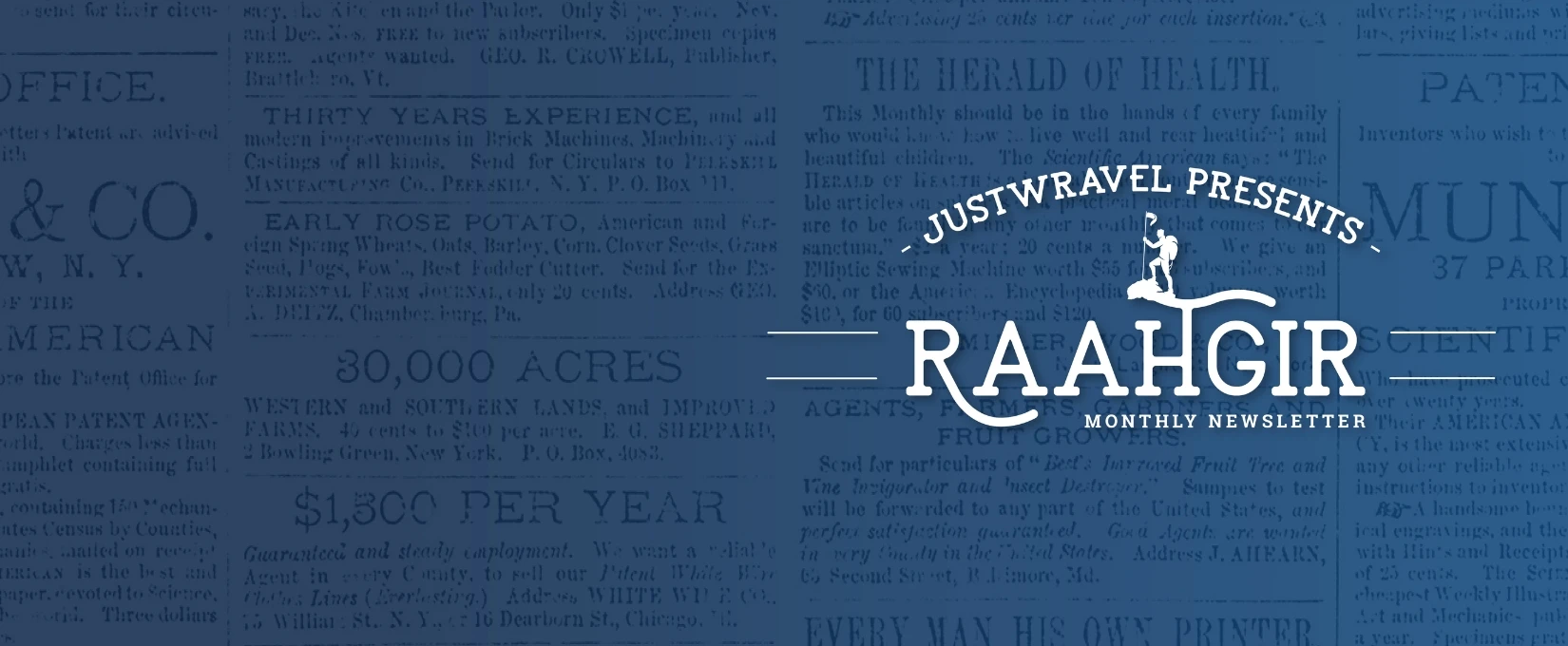
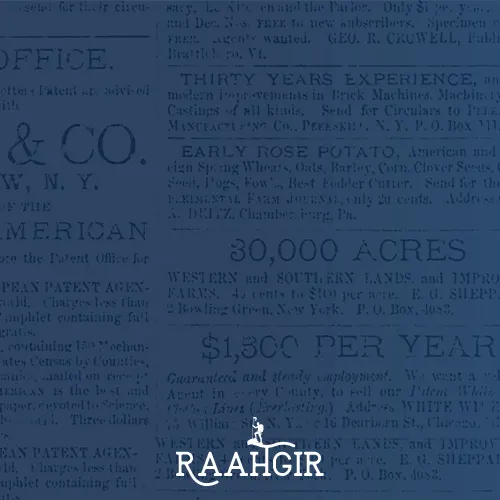
Newsletter
Sign up now!
Be the first one to know all about the Exciting Offers, Travel Updates and more.
Company
Contact Us
B-42, 2nd Floor, Tower- B,
The Corenthum, Block A, Sector 62, Noida, Uttar Pradesh 201301
© 2015-2025 JustWravel Pvt. Ltd.
Starts From
₹ 12,500

